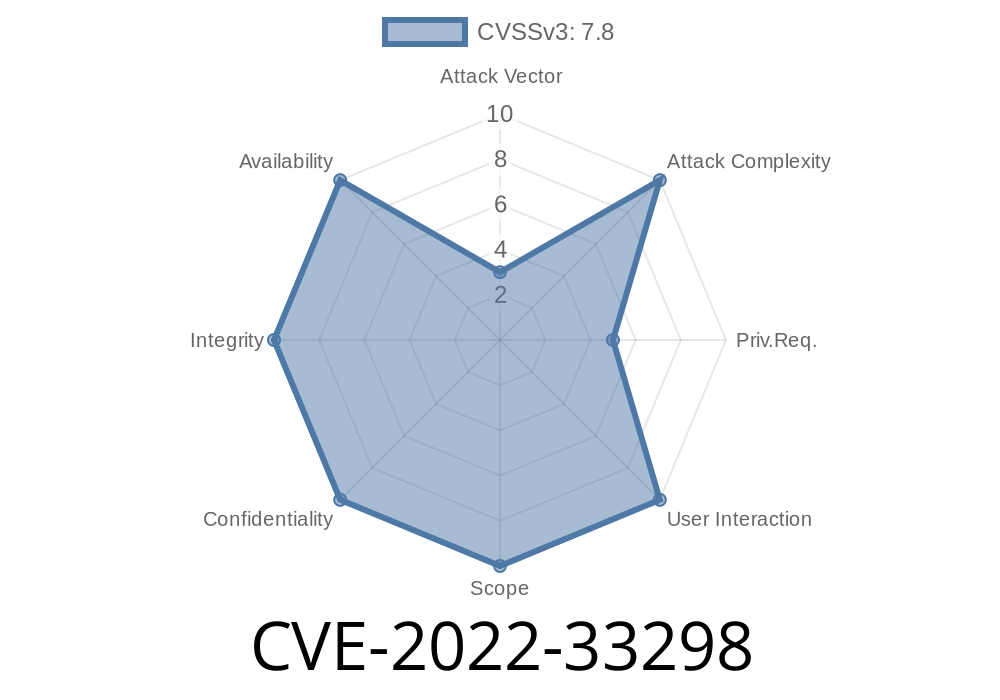A new vulnerability, tracked as CVE-2022-33298, has been discovered, affecting the initialization process of certain modem devices. This vulnerability arises due to the improper handling of memory allocation, specifically a 'use after free' error, which may lead to memory corruption. This, in turn, can potentially be exploited by attackers to gain unauthorized access and control over the affected device. In this long-read post, we will delve into the details of this vulnerability, as well as provide noteworthy code snippets, links to original references, and methods for exploiting the vulnerability.
Vulnerability Description
The CVE-2022-33298 vulnerability is due to the improper handling of memory allocation during the modem initialization process. When a modem device is started, it undergoes a series of processes to set up its communication and reception capabilities. During this initialization, a 'use after free' error occurs, where specific memory blocks are released but are still accessed afterward, resulting in memory corruption.
To better understand the issue, we should briefly discuss what 'use after free' means. In computer programming, memory allocation plays a crucial role in handling data during a program's execution. When a programmer reserves a memory block for data, they must also release the block after the data is no longer needed. 'Use after free' occurs when the freed memory block, which is no longer reserved, is still accessed by the program. This can lead to memory corruption, crashes, or even the execution of arbitrary code by malicious actors.
To illustrate the vulnerability, consider the following code snippet
typedef struct {
int data;
} modem_data;
void modem_init() {
modem_data* md = (modem_data*) malloc(sizeof(modem_data));
initialize_modem(md);
free(md); // Memory is freed.
// Vulnerable section: Use after free.
md->data = get_new_data(); // Memory is accessed after being freed, leading to potential memory corruption.
}
In the example, modem_init() is responsible for allocating memory for a modem_data structure, initializing the modem with initialize_modem(), and then releasing the allocated memory with free(). However, after freeing the memory, the code attempts to access the now-freed memory block with md->data = get_new_data() - this is the 'use after free' vulnerability that can lead to memory corruption.
Original References
For more information on the details of this vulnerability, including affected devices and possible fixes, consult the following original references:
1. National Vulnerability Database - CVE-2022-33298
2. CVE Details - CVE-2022-33298
Exploit Details
Exploiting this vulnerability would require an attacker to craft a specific sequence of actions that can cause the modem to reuse the previously freed memory block. For instance, an attacker may utilize heap spraying techniques to populate freed memory blocks with malicious payloads, increasing the chances that the 'use after free' error results in the execution of arbitrary code.
An attack scenario might involve the attacker intercepting communications between a vulnerable modem and its host device, injecting malicious code, and then causing the modem to execute the instructions contained in the corrupted memory block.
It is important to note that this type of exploit would require a sophisticated attacker with knowledge of target system internals and possibly physical access to the device. Nonetheless, as with any vulnerability, it is essential for users and administrators to stay informed on potential mitigation strategies and security updates.
Mitigation and Conclusion
To mitigate the risk posed by CVE-2022-33298, users should consider updating their modem devices' firmware to the latest available version, which should include fixes for this and other vulnerabilities. Additionally, system administrators should apply network security practices such as segmentation and secure authentication mechanisms to reduce the risk of unauthorized access to modem devices and their host systems.
In conclusion, CVE-2022-33298 demonstrates the importance of proper memory management, particularly during device initialization processes. By staying informed on the latest vulnerabilities and applying timely security updates, users and administrators can minimize the risks associated with such vulnerabilities.
Timeline
Published on: 04/13/2023 07:15:00 UTC
Last modified on: 04/24/2023 16:38:00 UTC
